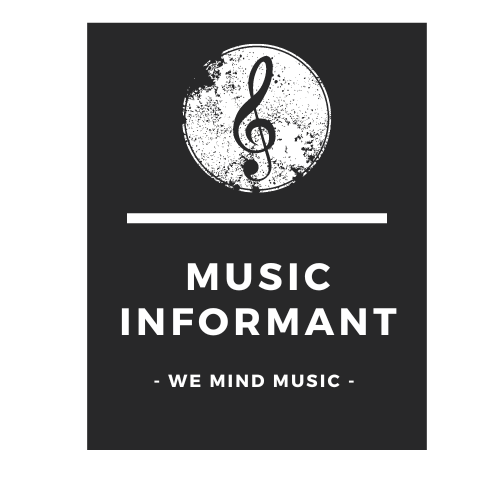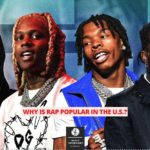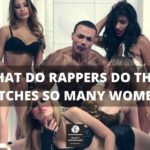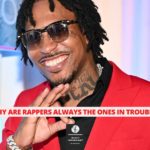
When Miley Cyrus referred to herself as a “white girl rapper” in an interview with Time magazine and had the internet buzzing, she sparked a debate. She wasn’t the first white woman to rap (remember those Vanilla Ice rumors). However, she was one of the most successful, and interestingly enough, still the only white female rapper that people seem to acknowledge.
Why Certain Rappers Considered “White People Rappers”?
Well, it’s pretty simple.
“White People Rappers” are those who were born in the United States but have not been raised within the community of Black Americans and African-Americans. They have grown up in predominantly white neighborhoods and have been influenced by their parents or peers’ music and culture. There are two types of White People Rappers: those who grew up around Black culture and those who did not grow up around Black culture.
The first type is what we think of when we talk about White People Rappers—they grew up around Black culture but were not raised by Black parents or guardians (usually).
Some examples include Eminem, Macklemore, and Chance The Rapper, who grew up around Black culture but were raised by white parents or guardians.
The second type is less common because they’re less likely to be famous than their counterparts—they’re more likely to be middle-class or lower-class citizens who still manage to make their way into the rap game through talent alone (unlike the first type). Their music is often centered on issues that affect them as white people growing up in America today: racism, police brutality, etc…
Ten rappers considered “White People Rappers”?
1. Eminem
2. Macklemore
3. Lil Dicky
4. Post Malone
6. Yelawolf
7. Juice WRLD
8. Young Thug
9. Joyner Lucas
10. 6ix9ine
Eminem
Eminem is considered a white rapper because he is white, and his music has been designed to appeal to white people.
The term “white rapper” refers to a rapper whose record label is designed to appeal to white people, as opposed to rap artists marketed towards black audiences.
Eminem’s music has been described as “white hip-hop” or “rap rock,”. A genre that emerged in the early 2000s when hip-hop artists started incorporating rock elements into their music. This was considered “white” because the rock has historically been associated with white people. It was an attempt to appeal to them since they were generally not interested in hip-hop culture.
In addition to this, Eminem’s lyrics often use racist and misogynistic language. Wwhich further solidifies his image as someone who would appeal more strongly to white people than black people.
Macklemore was considered a “White People Rapper.”
When you look at the list of rappers considered “White People Rappers,. It’s easy to see why people would think that. After all, most of the rappers on that list have names like Macklemore and Post Malone. So it’s not surprising that people might assume they’re white.
But there’s a good chance that listeners are wrong about these artists’ racial identities—in fact, many of them may be more accurately described as mixed-race artists than white artists. For example, Post Malone has a black father and an Irish mother; Macklemore is half-Jewish; and Eminem is half-German.
The answer lies in their music videos and lyrics. Most videos by white rappers feature white people. And the ones that don’t often feature nonwhite actors playing exaggerated versions of themselves (like Lil Dicky). Their lyrics often focus on themes like wealth and luxury—which can come off as insensitive when performed by someone who doesn’t share those experiences.
Lil Dicky
Rappers are the heartbeat of hip-hop music, but certain rappers are considered white people rappers. Lil Dicky is one of these rappers. He is a white rapper who makes music that appeals to white audiences. He and other white people rappers are considered “white people rappers” because they don’t fit into the stereotypical image of a rapper. A rapper is usually associated with being black and coming from an urban area, but not all rappers fit this description.
Lil Dicky has been making music since 2011 and has released three albums: Professional Rapper (2015), Laid Out (2016), and Freaky Friday (2019). He grew up in Pennsylvania and attended college at Drexel University, where he studied business management and marketing.
He started making YouTube videos in 2010 where he would rap about everyday things like his favorite cereal or his girlfriend cheating on him. with another man named Dicky (hence his stage name).
His videos went viral on social media platforms such as Twitter, Instagram, and Facebook.
He began making money off his videos through advertising revenue from companies like Google AdSense or Amazon Affiliate Links which helped him fund some of his early music projects such as Professional Rapper, which debuted at number 1 on Billboards.
Post Malone
Post Malone is considered a “White People Rapper” because he seems to embody what a White People Rapper looks like.
He’s tall, blonde, and has light-colored eyes. He comes from a privileged upbringing in America. And he’s incredibly catchy with his music.
But most importantly, he doesn’t seem to have any interest in rapping about controversial topics or addressing systemic racism or inequality in any way. Instead, he focuses on partying, partying some more, and then partying some more. His lyrics are almost always about having fun at parties or making money off of partying (or both).
That said: Post Malone isn’t the only white rapper who fits this description—it just so happens that he’s one of the best-known ones right now.
Machine Gun Kelly
Machine Gun Kelly is one of the most successful white rappers in the game today. However, he has not always been considered a “white people rapper.” Machine Gun Kelly got his start in hip-hop by making music for other artists. He then moved to Los Angeles, where he found work as a songwriter and producer for artists like Justin Bieber and Lady Gaga.
It wasn’t until 2010 that Machine Gun Kelly released his album. His first single was called “Wild Boy” and went straight to number one on iTunes. This success led many people to label him as a “white rapper,” probably due to his use of Auto-Tune and other pop elements in his music.
In 2013, Machine Gun Kelly released an album called Lace Up that featured songs like “Invincible” and “Till I Die.” The album received mixed reviews from critics but went on to sell over 100,000 copies within 24 hours of its release!
Yelawolf
Yelawolf is a white rapper who started rapping in 2006. He is currently signed to Shady Records, the label that Eminem created. Yelawolf was born Michael Wayne Atha and was raised in Alabama. His name Yelawolf comes from his Native American heritage, which he has on his mother’s side.
Yelawolf has been called a “white rapper” throughout his career and has even referred to himself as such. This is because he does not have an African-American background. Some people do not consider him an actual “hip-hop artist” because of this. Still, Yelawolf disagrees with them and says that he feels more connected to hip-hop than any other genre of music and that it’s his passion.
Yelawolf’s first album, Creekwater, was released in 2010 under Shady Records and featured collaborations with artists like Travis Barker (from Blink 182), Kid Rock, and Wiz Khalifa. He followed up with Radioactive in 2011, which won Best Rap Album at the 2012 American Music Awards.”
Juice WRLD
Juice WRLD is a rapper from Chicago who has gained a lot of popularity in the past few years. He is considered “white people rap” because he grew up in a primarily white neighborhood, and his music style isn’t as popular with black rappers.
Juice WRLD grew up in the suburbs of Chicago, Illinois, and attended high school at Marist High School.
His music was influenced by artists such as Future, Drake, Kanye West, and Travis Scott.
He also cites Kid Cudi as an influence on his style of rapping.
His music is known for its sad tone, which is often compared to the works of The Weeknd or Frank Ocean. His song “Lucid Dreams” became a hit after being featured on the soundtrack for “The Hate U Give.”
He has worked with other artists such as Kanye West and Lil Wayne, but most people know him from his single “All Girls Are The Same” from 2018’s album “I’m Still Waiting.” This single helped him gain popularity with fans who are not used to hearing hip-hop or rap artists who aren’t black males or females (like Cardi B).
Young Thug
There are a lot of reasons why Young Thug is considered a “White People Rapper.”
For one thing, he has a unique style of flow, which doesn’t match the traditional idea of what rap sounds like. Many say that his flow is more similar to spoken word poetry than hip-hop, and he often raps over beats that don’t have a traditional hip-hop feel. This can cause people who are used to traditional rap music to have trouble distinguishing between him and the other artists they’re used to hearing.
Another reason Young Thug is considered a “White People Rapper” might be because he looks different from most other rappers on the scene today. He’s got an unusual face shape and doesn’t wear much makeup or jewelry. These things make him stand out in a crowd compared to other artists in his genre. His clothes also tend toward bright colors and patterns, making him look even more different from his peers. More than if he were wearing all black (which many people associate with being “ghetto”).
Joyner Lucas is
Joyner Lucas, a rapper from the Bay Area and Los Angeles, is often considered a “White People Rapper.” This is because he has a very distinct style of rapping—he uses his voice to create beats more akin to acoustic music than traditional hip-hop beats. He also uses a lot of vocal effects, which gives his music a psychedelic feel.
Joyner started as part of a rap duo called Joyner Lucas & The Mixtape Messiahs, with whom he released two mixtapes: one in 2010 and another in 2012. The pair disbanded in 2013, but Joyner continued to make music on his own. In 2016 he released his third mixtape, called “Black Jesus.” That same year he signed with Atlantic Records and released his debut album, “Black Superman.”
Joyner’s sound differs from other rappers who use similar techniques because it’s more rooted in acoustic instrumentation than traditional hip-hop beats. He also uses more vocal effects than most rappers when producing beats or singing over them.
6ix9ine is
6ix9ine is considered a “White People Rapper” because he is not a member of the Black community, and he uses his fame to show off and make money. He has been accused of being racist, and he has also been accused of using his fame to promote bigotry.
6ix9ine’s songs are often about white culture and how he loves that culture. 6ix9ine describes himself as “white” in his songs, which makes him sound like a Nazi or an extreme nationalist. His music videos also feature him wearing clothes from brands like Gucci and Louis Vuitton, which are known for being expensive. It makes him appear wealthy rather than poor or middle class.
6ix9ine’s videos also often show him wearing clothes that look like they belong to someone else. He wears makeup and jewelry on his face. Makes it seem like he has money but is trying to hide it from other people, so they won’t know how rich he is.”
Conclusion: Why are certain rappers considered “White People Rappers”?
First, as is the case with all of these lists, this one only constitutes an attempt to be an exhaustive catalog. Other rappers can be considered white-people rappers. The list we have presented here is our attempt at highlighting the best in the genre, and there’s certainly a lot to celebrate. No matter what your definition of a “white-people rapper” is, it’s clear that they aren’t just a passing trend. Just look at our number one: Macklemore has been nominated for seven Grammys (and just recently won three), so he’s here to stay.
Some have described hip-hop artists such as Macklemore and Ryan Lewis as part of a “New Black Aesthetic.” Their success proves that we’ve come a long way from the days when being a talented musician was considered racist. It’s only fitting that two of the people on this list are biracial, which illustrates how far we have also come. It may not be long before trying to label an artist as “black” or “white” becomes obsolete, thanks to the increasing diversity in America.
However you define them, these artists deserve recognition for their contributions on and off the stage.
This article is written by @MusicInformant // All Rights Reserved.









